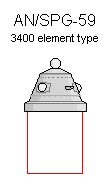Difference between revisions of "AN/SPG-59"
Acelanceloet (talk | contribs) (Created page with "thumb == History == This is main radar of the abortive Typhon system, employing a Luneberg lens for electronic beam-steering. Primary requireme...") |
Acelanceloet (talk | contribs) m (→Used on) |
||
| Line 11: | Line 11: | ||
* SCB 277 Typhon DLG proposals, 1961/62 | * SCB 277 Typhon DLG proposals, 1961/62 | ||
* BuShips Scheme 59H 1959 | * BuShips Scheme 59H 1959 | ||
| − | * BuShips Scheme 59C 1959 | + | * [http://www.shipbucket.com/drawings/7640 BuShips Scheme 59C 1959] |
== Affiliated systems == | == Affiliated systems == | ||
Revision as of 21:39, 3 June 2018
History
This is main radar of the abortive Typhon system, employing a Luneberg lens for electronic beam-steering. Primary requirements included large bandwidth and frequency independence in steering the beam, to avoid several types of countermeasure. The cylindrical Luneberg lens focussed a beam projected onto it from any point on its surface. In the complete system, a lens deep in the ship was used, in effect, as a computer to generate signals with the appropriate phase relationships, for transmission from a sphere atop the cylindrical housing of the radar. It proved necessary to amplify these signals to overcome losses, and 356 travelling-wave tube amplifiers (TWTs), originally not part of the design, had to be interposed between the lens and the radiating sphere. Three more spheres were used for reception.
One problem in system design was that the spheres had a very small effective radiating aperture, less than 4ft, which had to be balanced by high radiated power. Altogether, 1800 medium-power amplifiers and associated waveguides were required for the 'small ship' system, with proportionately more for the 10,000-element 'large ship' system. It was tested aboard Norton Sound after the cancellation of the system proper. As installed aboard the test ship, it had a maximum peak power of 8.7 MW (pulselengths of 2 microseconds for search, 0.1 microsecond for tracking, with jittered PRFs of, respectively, 200,000 and 400,000 on average burst) in C-band. Average power was 200MW, and pulse doppler operation provided high velocity resolution (100 fs in search, 9 fs in track). Range resolution was 20ft in search and 2ft in track, and acquisition range was stated as 165nm on a 1m2 target. In principle the system could handle up to ten targets at a 0.1-second data rate for high-precision (3.5-mil) tracking, and could control up to 30 defensive missiles at the same time. At a lower data rate (4 seconds) it could maintain track on up to 120 targets (TWS).
SPG-59 was designated to carry out a high-power hemispherical search, with acquisition on 1m2 targets (with a 6-14 second data rate, and a detection probability of 0.5) at 165nm (horizon to 5.1°), 155nm (to 8.5°) or 105nm (to 80°) and a low-power horizon search (37nm on a 0.5m2 target with a detection probability of 0.9 at a 1-second data rate). Like the current Aegis, Typhon envisaged command control of defensive missiles.
Used on
- SCB 277 Typhon DLG proposals, 1961/62
- BuShips Scheme 59H 1959
- BuShips Scheme 59C 1959
Affiliated systems
Part description
This component has, drawn in red, the deck penetration drawn in. This space is also part of the radar system, but is covered by superstructure that can vary in shape and size. The actual deck penetration is cylindrical.
See also
https://www.secretprojects.co.uk/forum/index.php/topic,690.0.html
